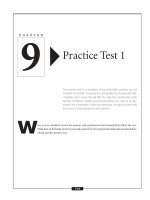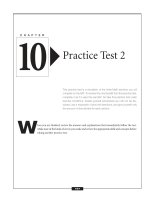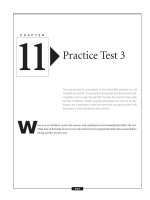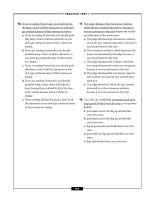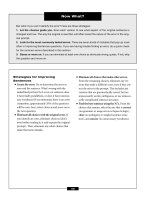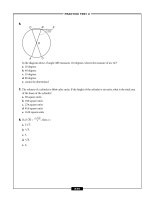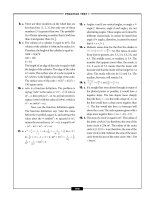Sat math essentials 7 potx
Bạn đang xem bản rút gọn của tài liệu. Xem và tải ngay bản đầy đủ của tài liệu tại đây (82.16 KB, 6 trang )
The radius of the circle is equal to 6, half its
diameter. The area of a circle is equal to πr
2
,
so the area of the circle is equal to 36π square
units.
12. d. The sides of a square and the diagonal of a
square form an isosceles right triangle. The
length of the diagonal is ͙2
ෆ
times the
length of a side. The diagonal of the square
is 16 ͙2
ෆ
cm, therefore, one side of the
square measures 16 cm. The area of a square
is equal to the length of one side squared:
(16 cm)
2
ϭ 256 cm
2
.
13. a. If both sides of the inequality
ᎏ
m
2
ᎏ
>
ᎏ
n
2
ᎏ
are mul-
tiplied by 2, the result is the original inequal-
ity, m > n. m
2
is not greater than n
2
when m is
a positive number such as 1 and n is a nega-
tive number such as –2. mn is not greater than
zero when m is positive and n is negative. The
absolute value of m is not greater than the
absolute value of n when m is 1 and n is –2.
The product mn is not greater than the prod-
uct –mn when m is positive and n is negative.
14. c. There are 60 minutes in an hour and 120
minutes in two hours. If 4 liters are poured
every 3 minutes, then 4 liters are poured 40
times (120 Ϭ 3); 40 ϫ 4 ϭ 160. The tank,
which holds 2,000 liters of water, is filled with
160 liters;
ᎏ
2
1
,0
6
0
0
0
ᎏ
ϭ
ᎏ
1
8
00
ᎏ
. 8% of the tank is full.
15. d. The curved portion of the shape is
ᎏ
1
4
ᎏ
πd,
which is 4π. The linear portions are both the
radius, so the solution is simply 4π ϩ 16.
16. 4 Multiply the number of appetizers, entrées,
and desserts offered at each restaurant. The
Scarlet Inn offers (2)(5)(4) ϭ 40 meal com-
binations, and the Montgomery Garden
offers (3)(4)(3) ϭ 36 meal combinations.
The Scarlet Inn offers four more meal
combinations.
17. 35 Angles OBC and OCB are congruent, so both
are equal to 55 degrees. The third angle in the
triangle, angle O, is equal to 180 – (55 ϩ 55)
ϭ 180 – 110 ϭ 70 degrees. Angle O is a cen-
tral angle; therefore, arc BC is also equal to 70
degrees. Angle A is an inscribed angle. The
measure of an inscribed angle is equal to half
the measure of its intercepted arc. The meas-
ure of angle A ϭ 70 Ϭ 2 ϭ 35 degrees.
18. 4 The function f(a) ϭ
ᎏ
(4a
2
(
ϩ
a
2
–
12
1
a
6
ϩ
)
9)
ᎏ
is undefined
when its denominator is equal to zero; a
2
– 16
is equal to zero when a ϭ 4 and when a ϭ –4.
The only positive value for which the func-
tion is undefined is 4.
19. 46 Over 12 hours, Kiki climbs (1,452 – 900) ϭ
552 feet. On average, Kiki climbs (552 Ϭ 12)
ϭ 46 feet per hour.
20. 55 The total weight of the first three dogs is
equal to 75 ϫ 3 ϭ 225 pounds. The weight of
the fourth dog, d, plus 225, divided by 4, is
equal to the average weight of the four dogs,
70 pounds:
ᎏ
d ϩ
4
225
ᎏ
ϭ 70
d ϩ 225 ϭ 280
d ϭ 55 pounds
21. 260 The weight Kerry can lift now, 312 pounds, is
20% more, or 1.2 times more, than the
weight, w, he could lift in January:
1.2w ϭ 312
w ϭ 260 pounds
22. 485 2,200(0.07) equals $154; 1,400(0.04) equals
$56; 3,100(0.08) equals $248; 900(0.03)
equals $27. Therefore, $154 ϩ $56 ϩ $248 ϩ
$27 ϭ $485.
23. 19 Let x, x ϩ 1, and x ϩ 2 represent the consec-
utive integers. The sum of these integers is 60:
x ϩ x ϩ 1 ϩ x ϩ 2 ϭ 60, 3x ϩ 3 ϭ 60, 3x ϭ
57, x ϭ 19. The integers are 19, 20, and 21, the
smallest of which is 19.
–MATH PRETEST–
24
24.
ᎏ
8
3
1
2
ᎏ
Each term is equal to the previous term mul-
tiplied by
ᎏ
3
2
ᎏ
. The fifth term in the sequence is
ᎏ
9
8
ᎏ
ϫ
ᎏ
3
2
ᎏ
ϭ
ᎏ
2
1
7
6
ᎏ
, and the sixth term is
ᎏ
2
1
7
6
ᎏ
ϫ
ᎏ
3
2
ᎏ
ϭ
ᎏ
8
3
1
2
ᎏ
.
25. –
ᎏ
1
4
ᎏ
The question is asking you to find the y-inter-
cept of the equation
ᎏ
2x
3
–
y
3
ᎏ
ϭ 4. Multiply both
sides by 3y and divide by 12: y ϭ
ᎏ
1
6
ᎏ
x –
ᎏ
1
4
ᎏ
.The
graph of the equation crosses the y-axis at
(0,–
ᎏ
1
4
ᎏ
).
26. 100 Set the measures of the angles equal to 1x,3x,
and 5x. The sum of the angle measures of a
triangle is equal to 180 degrees:
1x ϩ 3x ϩ 5x ϭ 180
9x ϭ 180
x ϭ 20
The angles of the triangle measure 20 degrees,
60 degrees, and 100 degrees.
27. 54 One face of the prism has a surface area of
nine square units and another face has a sur-
face area of 21 square units. These faces share
a common edge. Three is the only factor
common to 9 and 21 (other than one), which
means that one face measures three units by
three units and the other measures three units
by seven units. The face of the prism that is
identical to the face of the cube is in the shape
of a square, since every face of a cube is in the
shape of a square. The surface area of the
square face is equal to nine square units, so
surface area of one face of the cube is nine
square units. A cube has six faces, so the sur-
face area of the cube is 9 ϫ 6 ϭ 54 square
units.
28.
ᎏ
1
1
1
ᎏ
Seven cards are removed from the deck of
40, leaving 33 cards. There are three cards
remaining that are both a multiple of 4 and
a factor of 40: 4, 20, and 40. The probability
of selecting one of those cards is
ᎏ
3
3
3
ᎏ
or
ᎏ
1
1
1
ᎏ
.
29. 4 We are seeking D ϭ number of feet away
from the microwave where the amount of
radiation is
ᎏ
1
1
6
ᎏ
the initial amount. We are
given: radiation varies inversely as the square
of the distance or: R ϭ 1 Ϭ D
2
. When D ϭ 1,
R ϭ 1, so we are looking for D when R ϭ
ᎏ
1
1
6
ᎏ
.
Substituting:
ᎏ
1
1
6
ᎏ
ϭ 1 Ϭ D
2
. Cross multiplying:
(1)(D
2
) ϭ (1)(16). Simplifying: D
2
ϭ 16, or
D ϭ 4 feet.
30. 4 The factors of a number that is whole and
prime are 1 and itself. For this we are given x
and y, x > y > 1 and x and y are both prime.
Therefore, the factors of x are 1 and x, and the
factors of y are 1 and y. The factors of the
product xy are 1, x, y, and xy. For a given x
and y under these conditions, there are four
factors for xy, the product of the girls’ favorite
numbers.
–MATH PRETEST–
25
All Tests Are Not Alike
The SAT is not like the tests you are used to taking in school. It may test the same skills and concepts that your
teachers have tested you on, but it tests them in different ways. Therefore, you need to know how to approach the
questions on the SAT so that they don’t surprise you with their tricks.
CHAPTER
Techniques and
Strategies
The next four chapters will help you review all the mathematics you
need to know for the SAT. However, before you jump ahead, make sure
you first read and understand this chapter thoroughly. It includes tech-
niques and strategies that you can apply to all SAT math questions.
4
27
The Truth about Multiple-
Choice Questions
Many students think multiple-choice questions are
easier than other types of questions because, unlike
other types of questions, they provide you with the
correct answer. You just need to figure out which of the
provided answer choices is the correct one. Seems sim-
ple, right? Not necessarily.
There are two types of multiple-choice questions.
The first is the easy one. It asks a question and provides
several answer choices. One of the answer choices is
correct and the rest are obviously wrong. Here is an
example:
Who was the fourteenth president of the United
States?
a. Walt Disney
b. Tom Cruise
c. Oprah Winfrey
d. Franklin Pierce
e. Homer Simpson
Even if you don’t know who was the fourteenth
president, you can still answer the question correctly
because the wrong answers are obviously wrong. Walt
Disney founded the Walt Disney Company, Tom Cruise
is an actor, Oprah Winfrey is a talk show host, and
Homer Simpson is a cartoon character. Answer choice
c, Franklin Pierce, is therefore correct.
Unfortunately, the SAT does not include this type
of multiple-choice question. Instead, the SAT includes
the other type of multiple-choice question. SAT ques-
tions include one or more answer choices that seem
correct but are actually incorrect. The test writers include
these seemingly correct answer choices to try to trick
you into picking the wrong answer.
Let’s look at how an SAT writer might write a
question about the fourteenth president of the United
States:
Who was the fourteenth president of the United
States?
a. George Washington
b. James Buchanan
c. Millard Fillmore
d. Franklin Pierce
e. Abraham Lincoln
This question is much more difficult than the
previous question, isn’t it? Let’s examine what makes it
more complicated.
First, all the answer choices are actual presidents.
None of the answer choices is obviously wrong. Unless
you know exactly which president was the fourteenth,
the answer choices don’t give you any hints. As a result,
you may pick George Washington or Abraham Lincoln
because they are two of the best-known presidents.
This is exactly what the test writers would want you to
do! They included George Washington and Abraham
Lincoln because they want you to see a familiar name
and assume it’s the correct answer.
But what if you know that George Washington
was the first president and Abraham Lincoln was the
sixteenth president? The question gets even trickier
because the other two incorrect answer choices are
James Buchanan, the thirteenth president, and Mil-
lard Fillmore, the fifteenth president. In other words,
unless you happen to know that Franklin Pierce was the
fourteenth president, it would be very difficult to fig-
ure out he is the correct answer based solely on the
answer choices.
In fact, incorrect answer choices are often called
distracters because they are designed to distract you
from the correct answer choice.
This is why you should not assume that multiple-
choice questions are somehow easier than other types
of questions. They can be written to try to trip you up.
But don’t worry. There is an important technique
that you can use to help make answering multiple-
choice questions easier.
–TECHNIQUES AND STRATEGIES–
28
Finding Four Incorrect Answer
Choices Is the Same as
Finding One Correct Answer
Choice
Think about it: A multiple-choice question on the SAT
has five answer choices. Only one answer choice is cor-
rect, which means the other four must be incorrect. You
can use this fact to your advantage. Sometimes it’s eas-
ier to figure out which answer choices are incorrect
than to figure out which answer choice is correct.
Here’s an exaggerated example:
What is 9,424 ϫ 2,962?
a. 0
b. 10
c. 20
d. 100
e. 27,913,888
Even without doing any calculations, you still
know that answer choice e is correct because answer
choices a, b, c, and d are obviously incorrect. Of course,
questions on the SAT will not be this easy, but you can
still apply this idea to every multiple-choice question on
the SAT. Let’s see how.
Get Rid of Wrong Answer
Choices and Increase
Your Luck
Remember that multiple-choice questions on the SAT
contain distracters: incorrect answer choices designed
to distract you from the correct answer choice. Your job
is to get rid of as many of those distracters as you can
when answering a question. Even if you can get rid of
only one of the five answer choices in a question, you
have still increased your chances of answering the ques-
tion correctly.
Think of it this way: Each SAT question provides
five answer choices. If you guess blindly from the five
choices, your chances of choosing the correct answer
are 1 in 5, or 20%. If you get rid of one answer choice
before guessing because you determine that it is incor-
rect, your chances of choosing the correct answer are 1
in 4, or 25%, because you are choosing from only the
four remaining answer choices. If you get rid of two
incorrect answer choices before guessing, your chances
of choosing the correct answer are 1 in 3, or 33%. Get
rid of three incorrect answer choices, and your chances
are 1 in 2, or 50%. If you get rid of all four incorrect
answer choices, your chances of guessing the correct
answer choice are 1 in 1, or 100%! As you can see, each
answer choice you eliminate increases your chances of
guessing the correct answer.
ODDS YOU CAN
NUMBER OF GUESS THE
DISTRACTERS CORRECT
YOU ELIMINATE ANSWER
0 1 in 5, or 20%
1 1 in 4, or 25%
2 1 in 3, or 33%
3 1 in 2, or 50%
4 1 in 1, or 100%
Of course, on most SAT questions, you won’t be
guessing blindly—you’ll ideally be able to use your
math skills to choose the correct answer—so your
chances of picking the correct answer choice are even
greater than those listed above after eliminating
distracters.
–TECHNIQUES AND STRATEGIES–
29
